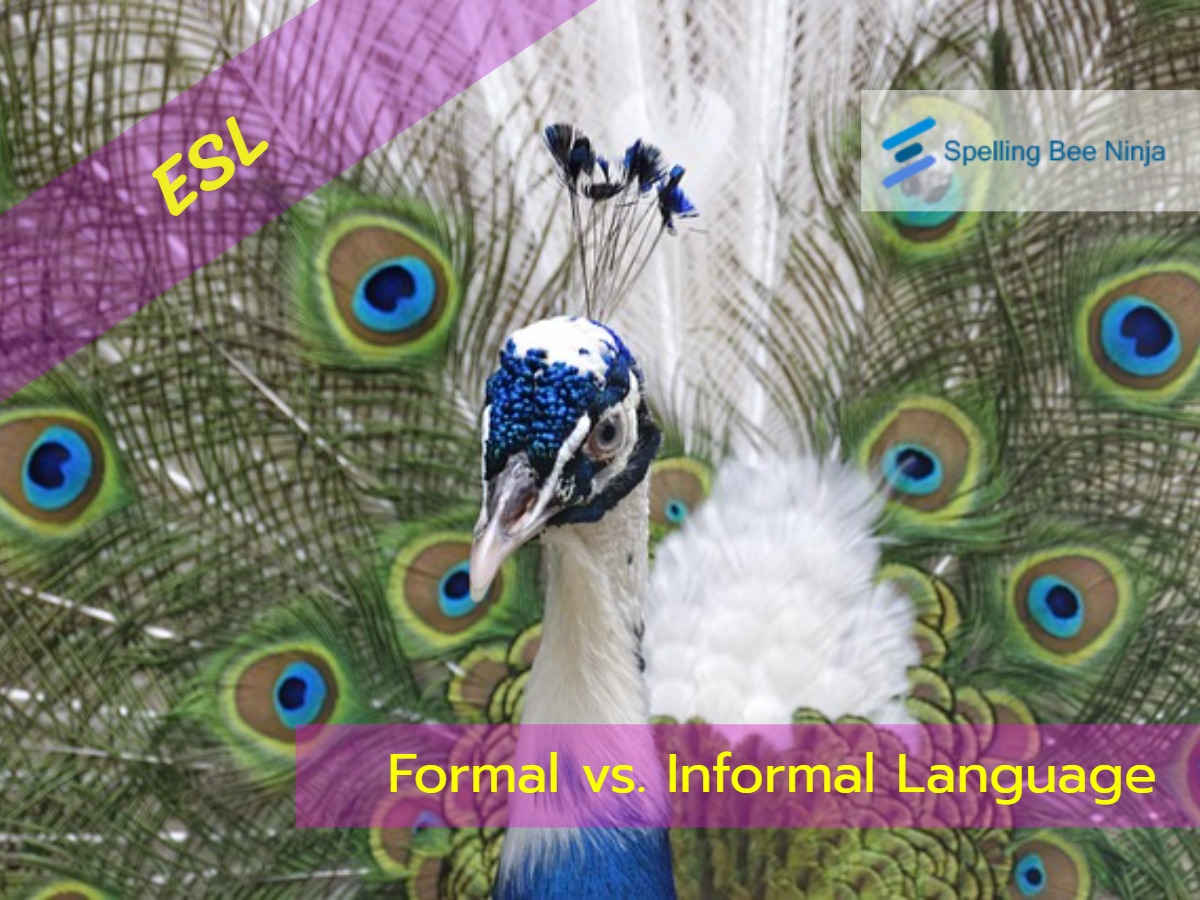Introduction
Language is a powerful tool that helps us communicate our thoughts, feelings, and ideas. But did you know that the way we speak or write can change depending on who we are talking to or the situation we are in? This is where formal and informal language come in. Understanding the difference between formal and informal language is very important, especially for ESL (English as a Second Language) learners and students in K-12 schools. This article will explain what formal and informal language are, when to use each, and give you helpful tips to improve your English skills.
What is Formal Language?
Formal language is a style of speaking or writing that is polite, respectful, and follows the rules of grammar carefully. It is often used in serious or official situations. For example, you use formal language when writing a letter to your teacher, giving a speech, or talking to someone you don’t know very well.
Characteristics of Formal Language
Complete sentences: Formal language uses full sentences with proper grammar.
No slang or contractions: Words like “can’t,” “won’t,” or “gonna” are avoided. Instead, you say “cannot,” “will not,” or “going to.”
Polite and respectful tone: Formal language is polite and shows respect.
More complex vocabulary: Words tend to be more advanced and precise.
Passive voice: Sometimes formal language uses passive voice to sound more objective (e.g., “The report was written by the student”).
Examples of Formal Language
“I am writing to inform you about the upcoming exam.”
“Could you please provide me with the necessary information?”
“It is important to complete your homework on time.”
What is Informal Language?
Informal language is more relaxed and casual. It is the way we speak with friends, family, or people we know well. Informal language is common in everyday conversations, text messages, or social media posts.
Characteristics of Informal Language
Shorter sentences: Sentences can be shorter and sometimes incomplete.
Use of slang and contractions: Words like “gonna,” “wanna,” “cool,” or “awesome” are common.
Friendly and personal tone: Informal language sounds warm and friendly.
Simple vocabulary: Words are easy and common.
Use of idioms and expressions: Informal language often includes phrases like “hang out,” “catch up,” or “what’s up?”
Examples of Informal Language
“Hey! What’s up?”
“I’m gonna go to the mall later.”
“That movie was awesome!”
When to Use Formal Language
Knowing when to use formal language is very important because it shows respect and professionalism. Here are some situations where formal language is best:
School assignments and essays: Teachers expect formal writing in your homework and essays.
Speaking with teachers or principals: When talking to school staff, use formal language to show respect.
Job interviews or applications: If you apply for a job or internship, formal language helps you sound serious and professional.
Official letters or emails: Writing to someone you don’t know well or in a business context requires formal language.
Public speaking: Giving presentations or speeches usually needs formal language.
When to Use Informal Language
Informal language is perfect for casual, everyday situations. Here are some examples:
Talking with friends and family: When chatting with people you know well, informal language is natural.
Text messages and social media: Informal language is common in texting or posting on social media.
Casual conversations: When you are relaxed and having fun, informal language fits best.
Personal emails or notes: Writing to close friends or family members can be informal.
How to Switch Between Formal and Informal Language
Switching between formal and informal language is a skill that takes practice. Here are some tips to help you:
Think about your audience: Ask yourself who you are talking or writing to. Is it a teacher, a friend, or a stranger?
Consider the situation: Is this a serious or casual situation?
Choose your words carefully: Use polite and complete sentences for formal language. Use simple and friendly words for informal language.
Avoid slang in formal writing: Save slang and contractions for informal conversations.
Practice writing both ways: Try writing a formal email and an informal text about the same topic.
Examples: Formal vs. Informal Language
| Situation | Formal Language | Informal Language |
|---|---|---|
| Asking for help | “Could you please help me with this assignment?” | “Hey, can you help me with this?” |
| Saying goodbye | “Goodbye. Have a nice day.” | “See you later!” |
| Inviting someone | “I would like to invite you to my birthday party.” | “Hey, wanna come to my party?” |
| Apologizing | “I apologize for the mistake I made.” | “Sorry about that!” |
More examples:
| # | Formal Language | Informal Language |
|---|---|---|
| 1 | I am writing to inform you | Just wanted to let you know |
| 2 | Could you please help me? | Can you help me? |
| 3 | I would appreciate your assistance | I’d really like your help |
| 4 | I apologize for the inconvenience | Sorry about the trouble |
| 5 | Thank you for your consideration | Thanks for understanding |
| 6 | I look forward to your reply | Hope to hear from you soon |
| 7 | Please accept my sincere apologies | Sorry about that |
| 8 | It is a pleasure to meet you | Nice to meet you |
| 9 | I regret to inform you | I’m sorry to say |
| 10 | I am writing to request | I’m asking for |
| 11 | I would be grateful if you could | Could you please |
| 12 | Kindly let me know | Let me know |
| 13 | I am pleased to inform you | I’m happy to tell you |
| 14 | Please do not hesitate to contact me | Feel free to contact me |
| 15 | I am available at your convenience | I’m free whenever |
| 16 | I would like to schedule a meeting | Let’s set up a meeting |
| 17 | Thank you for your prompt response | Thanks for getting back to me quickly |
| 18 | I appreciate your understanding | Thanks for understanding |
| 19 | Please find attached the document | I’ve attached the document |
| 20 | I am writing with regard to | I’m writing about |
| 21 | I hope this message finds you well | Hope you’re doing well |
| 22 | I would like to express my gratitude | Thanks a lot |
| 23 | I am looking forward to our collaboration | Can’t wait to work together |
| 24 | Please confirm your attendance | Let me know if you’re coming |
| 25 | I would be honored to | I’d love to |
| 26 | I am writing to follow up on | Just checking in on |
| 27 | I would like to bring to your attention | I want to tell you about |
| 28 | Your cooperation is greatly appreciated | Thanks for your help |
| 29 | I am writing to express my concern | I’m worried about |
| 30 | Please accept my heartfelt thanks | Thanks so much |
Comparison between a formal and informal letter
Formal Version
Subject: Request for Extension on Homework Deadline
Dear Mr. Smith,
I hope this message finds you well. I am writing to kindly request an extension on the deadline for the history homework assignment due this Friday. Unfortunately, I have been unwell this week and was unable to complete the work on time.
I would greatly appreciate it if you could grant me an additional three days to submit the assignment. I assure you that I will use this time to complete the work thoroughly.
Thank you very much for your understanding and consideration.
Sincerely,
Emily Johnson
Informal Version
Hey Mr. Smith,
I just wanted to ask if I could have a few more days to finish the history homework. I’ve been feeling sick this week and didn’t get it done yet.
It’d be awesome if you could give me until Monday to turn it in. I promise I’ll get it done by then.
Thanks a lot!
Emily
Why is Understanding Formal and Informal Language Important for ESL Learners?
For ESL learners, knowing the difference between formal and informal language is very important because it helps you:
Communicate clearly: You can choose the right words for the right situation.
Make a good impression: Using formal language when needed shows respect and professionalism.
Avoid misunderstandings: Using informal language in formal situations can seem rude or careless.
Improve your writing and speaking skills: Practicing both styles helps you become a better English speaker and writer.
Fun Activities to Practice Formal and Informal Language
Here are some fun ways to practice:
Role-play: Pretend you are in different situations, like talking to a teacher or chatting with a friend. Practice using formal and informal language.
Write two versions: Pick a topic and write one formal paragraph and one informal paragraph.
Watch videos or listen to conversations: Notice when people use formal or informal language.
Create flashcards: Write formal phrases on one side and informal phrases on the other.
Final Tips for ESL Learners and Students
Always pay attention to the situation and who you are speaking or writing to.
When in doubt, it’s safer to use formal language, especially in school or work.
Don’t be afraid to ask your teacher or a native speaker for help.
Practice regularly to become more confident.
Remember, both formal and informal language are important parts of English!
- Take our verification test below
By understanding and practicing formal and informal language, you will improve your communication skills and feel more confident in different situations. Keep practicing, and soon you will be able to switch easily between formal and informal English like a pro!
- ✈️ How to Use Articles in English
- 🐝 Mastering Adjectives: A Key to Enhancing Your Writing Skills
- 🎮 Pronoun Puzzle: A Fun Way to Practice Personal and Possessive Forms
- 🎮 Adjective Adventure: Descriptive Word Search!
- ✈️ How to use prepositions in English
- ✈️ English Adverbs – 5 Quick and Easy ways to learn.
- The definitive pronouns list
- 🐝 Understanding conjunction words and where to use them
- ✈️ Modal Verbs in English: A Comprehensive Guide
- 🐝 Prepositions list – The definitive guide
- ✈️ Active and Passive Voice
- ✈️ What vs Which: differences and examples
- 🐝 Complete transition words list
- ✈️ How to Use Punctuation in English
- ✈️ Exploring the Difference Between “Will” and “Shall” in English
- ✈️ The Difference Between Could, Should, and Ought in English
- ✈️ Common Idiomatic Expressions in English
- ✈️ 40 English Prefixes and their meanings
- ✈️ 30 Most common English suffixes and their meaning.
- 🐝 Linking Words In English And How To Learn Them Effectively
- ✈️ Comparative and Superlative Adjectives
- ✈️ The Six Noun Types (Common, Proper, Countable, Uncountable, Collective, Abstract)
- ✈️ Understanding English Clauses: A Complete Guide
- ✈️ Understanding Sentence Structure in English
- ✈️ Gerunds and Infinitives: Understanding Verb Complements in English
- ✈️ Common Pronunciation Mistakes and How to Fix Them
- ✈️ Question Formation in English
- ✈️ Common Sentence Errors: Fragments, Run-ons, and Misplaced Modifiers
- ✈️ Say What?! A Fun Guide to Direct and Indirect Speech
- ✈️ Commonly Confused Words
- 🐝 ELA vocabulary: Essential English Language Arts Terms Every Student Should Know
- ✈️ Formal vs. Informal Language
- ✈️ Mastering Phrases in English Grammar
- ✈️ Conditionals (Zero, First, Second, Third, Mixed Conditionals)
- ✈️ Emphasis and Inversion in Sentences
- ✈️ Understanding and Using the Imperative Form


